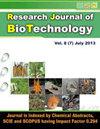In silico studies on characterization of glucosinolate derivatives for inhibition ofcell cycle regulation protein BCL-2
IF 0.2
Q4 BIOTECHNOLOGY & APPLIED MICROBIOLOGY
引用次数: 0
Abstract
Glucosinolates (GSL) are well-known secondary metabolites present in plants belonging to the Brassicaceae family (Cabbage, broccoli, cauliflower and brussels sprouts) and have been studied for their pharmacological properties. Glucosinolate is a sulfur-rich anionic hydrolyzed product which is good for the human diet. Through the enriched diet, the myrosinase enzyme hydrolyzes glucosinolates to form isothiocyanates against bacterial and fungal infections. Glucosinolates also show antimicrobial, anti-inflammatory, anticancer and cholinesterase inhibitor activity. The present study is to evaluate the glucosinolate substructures retrieved from the chemical database and to evaluate to understand that the BCL-2 inhibition showed the tumor growth and induced apoptosis. We retrieved 117 glucosinolate compounds and in silico druglike prediction screened the compounds and molecular docking against the BCL-2 protein structure. Based on the druglikeness analysis, we identified 39 compounds and these compounds were used for the inhibitory study with BCL2 protein. The results show that 2-Methyl-2-propenyl glucosinolate, 4-Methylpentyl glucosinolate, 4-Mercaptobutyl glucosinolate, Glucocapparin, Glucoerucin, Glucolepidiin, Glucoputranjivin, Glucoviorylin, n-Butyl glucosinolate compounds are strongly binding to BCL-2 protein structure by forming three hydrogen bonds and the resultant compounds can be used as a potential lead molecule for BCL-2 inhibitors.抑制细胞周期调控蛋白 BCL-2 的葡萄糖苷酸衍生物特征的硅学研究
葡萄糖苷酸盐(GSL)是芸苔科植物(卷心菜、西兰花、花椰菜和球芽甘蓝)中众所周知的次级代谢产物,其药理特性已得到研究。葡萄糖苷酸是一种富含硫的阴离子水解产物,对人类饮食有益。通过丰富的膳食,肌氨酸酶会水解葡萄糖苷酸盐,形成异硫氰酸酯,从而抵御细菌和真菌感染。葡萄糖苷酸盐还具有抗菌、消炎、抗癌和抑制胆碱酯酶的活性。本研究旨在评估从化学数据库中检索到的葡萄糖苷酸亚基结构,并评估其对 BCL-2 的抑制作用是否能抑制肿瘤生长和诱导细胞凋亡。我们检索了 117 个葡萄糖苷酸化合物,并针对 BCL-2 蛋白结构对化合物进行了硅学类药物预测筛选和分子对接。根据药物相似性分析,我们确定了 39 个化合物,并将这些化合物用于对 BCL2 蛋白的抑制研究。结果表明,2-甲基-2-丙烯基葡萄糖苷酸、4-甲基戊基葡萄糖苷酸、4-巯基丁基葡萄糖苷酸、糖苷元、葡萄糖醛酸、葡萄糖醛酸苷、葡萄糖苷元、正丁基葡萄糖苷酸化合物通过形成三个氢键与 BCL-2 蛋白结构强结合,这些化合物可作为 BCL-2 抑制剂的潜在先导分子。
本文章由计算机程序翻译,如有差异,请以英文原文为准。
求助全文
约1分钟内获得全文
求助全文
来源期刊

Research Journal of Biotechnology
BIOTECHNOLOGY & APPLIED MICROBIOLOGY-
CiteScore
0.60
自引率
0.00%
发文量
192
期刊介绍:
We invite you to contribute Research Papers / Short Communications / Review Papers:
-In any field of Biotechnology, Biochemistry, Microbiology and Industrial Microbiology, Soil Technology, Agriculture Biotechnology.
-in any field related to Food Biotechnology, Nutrition Biotechnology, Genetic Engineering and Commercial Biotechnology.
-in any field of Biotechnology related to Drugs and Pharmaceutical products for human beings, animals and plants.
-in any field related to Environmental Biotechnolgy, Waste Treatment of Liquids, Soilds and Gases; Sustainability.
-in inter-realted field of Chemical Sciences, Biological Sciences, Environmental Sciences and Life Sciences.
-in any field related to Biotechnological Engineering, Industrial Biotechnology and Instrumentation.
-in any field related to Nano-technology.
-in any field related to Plant Biotechnology.
 求助内容:
求助内容: 应助结果提醒方式:
应助结果提醒方式:


